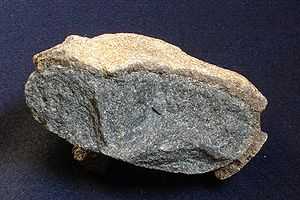Spheroidal weathering


Spheroidal weathering, sometimes called woolsack weathering, is a type of chemical weathering that creates rounded boulders and helps to create domed monoliths. This should not be confused with stream abrasion, a physical process which also creates rounded rocks on a much smaller scale. A good example of spheroidal weathering can be found in the Alabama Hills area of eastern California or at the Felsenmeer at the Odenwald, Germany.
Spheroidal weathering occurs whenever a mass of rock (most typically granitic in composition), experiences a drastic reduction in ambient heat and pressure, such as when a batholith is exposed at the surface. Rock forms at great temperatures and pressures (760 °C and 300 MPa, for granitic rock), and in granites there are three mutually perpendicular sets of joints that develop when this overburden is removed. Two things cause this in granites: the quartz crystals expand about 5%, and acidic water attacks the feldspar minerals, turning them into clay. Thus the corners become rounded, because angular edges provide more than one area of attack by exposing a greater amount of surface area. Edges and especially corners of an angular block weather faster than flatter surfaces. The ultimate result of this process is a rounded boulder or a dome monolith such as the rounded back of Half Dome in Yosemite National Park.
The process of spheroidal weathering is slower than other common types of weathering such as frost wedging, and it becomes lower still at progressively lower temperatures which slow down the chemical process of feldspar breakdown. Thus many granitic mountain peaks are jagged and craggey instead of rounded.
See also
- Exfoliation (geology), a related form of weathering that also creates domes.
- Granite dome
References
- Geology Underfoot in Death Valley and Owens Valley, Sharp, Glazner (Mountain Press Publishing Company, Missoula; 1997) ISBN 0-87842-362-1
- "Vulkanbomben?". Gomeraflora.de. 2012-05-15. Retrieved 2012-06-02.